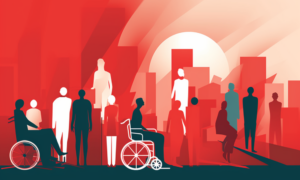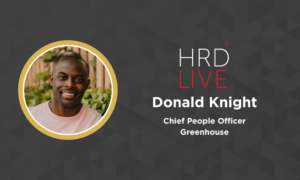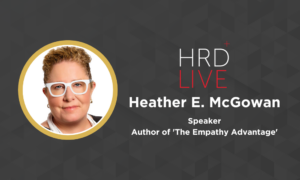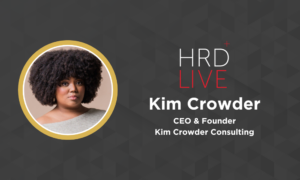Is unconscious bias a ‘get-out-of-jail-free card’?
- 7 Min Read
By focusing on unconscious bias, are People Leaders doing more harm than good?
- Author: Michael Hocking
- Date published: Nov 14, 2019
- Categories

Since the Harvard University ‘Implicit Association Test’ of 1998, which, its founders claimed, could detect the unconscious roots of privilege, the term ‘unconscious bias’ has grown in popularity to occupy a space in the common lexicon, in addition to becoming the phrase du jour of diversity and inclusion thought leadership over the last few years.
‘Unconscious bias’, referring to unintentional and automatic prejudices that influence behavior, has birthed a host of research projects and change initiatives in academia and business. This is unsurprising, given the woeful state of diversity in business, particularly at board level – such as a recent survey that revealed there are more CEOs called ‘Steve’ in FTSE 100 companies than CEOs of ethnic minority backgrounds.
I was recently struck by a powerful argument made by Dr. Keon West, Professor of Psychology at Goldsmiths University and founder of Equalab, speaking on BBC Radio 4[1] about unconscious bias. Dr. West argued that focusing on the issue of whether harm is unconscious or not is misguided – that it is the harm perpetrated by bias that is the key issue, and that real, conscious and tangible biases are still highly prevalent.
This means that, to an extent, to focus on unconscious bias shifts the blame for harm away from the perpetrator – if my actions were unconscious, it follows that I can’t be held fully responsible for them, as I am not fully in control of my unconscious.
There is a compelling, and disquieting, argument here. Is our focus on unconscious bias a kind of mass complicity with harmful prejudice, an attempt to sweep our biases under the carpet, or hand ourselves a ‘get-out-of-jail-free card’?
I asked some of HRD Connect’s most influential thought leaders on the subject of inclusion for their insights into whether or not unconscious bias is, indeed, a ‘get-out-of-jail-free card’.
“It can be a ‘get-out-jail-free-card’, said Janine Truitt, Chief Innovations Officer, Talent Think Innovations.
“There is this notion that the unintentional nature of unconscious bias makes it more palatable than more blatant attempts of bias and discrimination. I would argue that blatant attempts of bias are more palatable to a degree because there is no second-guessing the motive or intent. The inconvenient truth about unconscious bias is that, often-times, unintentional behavior has the look and feel of intentional behavior.”
“The presupposed, unintentional nature of unconscious bias can seek to absolve the individual of wrongdoing due to the brain’s ability to inform action or behavior seemingly out of the person’s sphere of influence.”
“Ignorance of what hurts or harms can only last for so long before those impacted call into question your consistency in latching onto excuses, and your unwillingness to educate yourself, so as to not commit the same infractions over and over again.”
“The sentiment tends to be, “If I play like I’m extremely apologetic or unknowing, people will take pity on me, rather than taking responsibility for how I impact people on a daily basis.”
In this sense, it seems that the effects of focusing on unconscious bias can be quite harmful, as it can make reporting prejudiced behavior a more complicated process, thereby making any remedy harder to reach.
“It depends how it is used,” said Stephen Frost, founder of the workplace team at Stonewall and CEO of Frost Included.
“If it’s a one-off tick box exercise it can be counterproductive. It can allow moral licencing, where professionals who have undertaken unconscious bias training have a false sense of competence. We see many professionals continue exactly as they did previously, but now with a mistaken notion that they are debiased. Unconscious bias training can even be used to justify questionable decisions. Frank Dobbin and others write of the harm diversity training can do to overall inclusion efforts.”
“However, if it is an introductory session to raise awareness, followed up by sessions where we work on implementation strategies to mitigate bias or improve business outcomes, then it can play a valuable role. For example, if tech companies followed UB training with workshops to debias their algorithms or processes, it could be helpful for all of us.”
The particular focus, or area within business, towards which unconscious bias training is directed, is also an important factor. Rather than do away with it entirely, perhaps it is an issue of refocusing the strategic use of unconscious bias training.
“Strategies for controlling bias – which drive most diversity efforts – have failed spectacularly since they were introduced,” said Pamela Brown, Head of Diversity & Inclusion, West Midlands Ambulance Service.
“The problem is that we can’t motivate people by forcing them to get training and punishing them if they don’t.”
“The numbers sum it up. Unconscious bias training does not translate into changed behaviour and actions and often reinforces the bias even further. In fact, I would suggest we actively use so-called unconscious bias not as a training tool, but rather a management tool to change behaviour.”
This would suggest that a pronounced focus on unconscious bias, when directed towards employees, is unwise. If this is the case, what should People Leaders do to remedy the harmful effects of bias within their organisations?
“Leaders have to take control and show the culture they want their organization to have”, said Jazmine Wilkes, HR Generalist and founder of HR Jazzy.
“Every organization has something it can do to truly start making the difference to be inclusive, but the leaders have to be willing to head that change and get rid of people who won’t accept it.”
“While HR loves a good policy, it will only go so far. Yes, create one to include all people from all walks of life, but then stick to it. As an organization, go outside of your comfort zone and make sure you’re reaching out to every audience for that stem job, not just a top university.
“This suggestion can seem like one that is very easy and has been given many times, but we are still discussing the basics of inclusion and that’s the problem.”
“’Nothing about us without us’ is a great mantra from the disability rights movement, and I would apply here also,” said Stephen Frost.
“Instead of doing anything for a group, do something with a group – become an ally and be led by them as to what’s most helpful, be it a policy audit to check equal benefits, setting up a network group or advocating for change. Generally, work on your own behaviours and leadership style to allow greater inclusion of people who are different from the prevailing norm.”
“Leaders need to take an honest look at the organization through the lens of culture and subculture. They ought to be willing to unearth difficult truths about how the organization and the work impact the employee’s ability to feel accepted, be seen, and heard,” continued Janine Truitt.
“Encouraging transparent communication around work experiences can go a long way in creating a necessary vehicle for gathering information about how people are being treated and included in the work environment.”
Fundamentally, it seems that the crucial issue here is openness, transparency, and a willingness to confront our own biases. It today’s ‘cancel culture’, it can be tempting to hide from these shortcomings and refuse to address them, for fear of criticism. But doing so not only prevents any meaningful change from occurring, but can actively exacerbate the existing biases that continue to cause real harm in the workplace.
People Leaders, and all business leaders, for that matter, must do more to create a culture of honesty, transparency and self-revelation in their workplaces. Whether this is through a renewed approach to learning, a total transformation of recruitment process, or a cultural revaluation – this transformation must begin with our willingness to change.
What do you think about unconscious bias? Tweet @HRDCommunity and let us know your thoughts.
[1] You can find out more about Dr. Keon West’s programme, ‘I Can’t Be Racist…’, and his work on unconscious bias here: https://www.bbc.co.uk/programmes/m0002rkq and here https://www.bbc.co.uk/programmes/articles/21wxrfj5S79pz6CMCdHmVL3/what-you-can-do-to-spot-and-stop-unconscious-bias.









